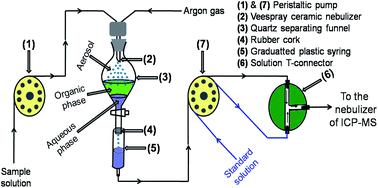当前位置:
X-MOL 学术
›
J. Anal. At. Spectrom.
›
论文详情
Our official English website, www.x-mol.net, welcomes your feedback! (Note: you will need to create a separate account there.)
Determination of critical trace impurities in “uranium silicide dispersed in aluminium” nuclear fuel by inductively coupled plasma mass spectrometry (ICP-MS)
Journal of Analytical Atomic Spectrometry ( IF 3.4 ) Pub Date : 2020-12-16 , DOI: 10.1039/d0ja00391c Abhijit Saha 1, 2, 3, 4 , Khushboo Kumari 1, 2, 3, 4 , Sadhan Bijoy Deb 1, 2, 3, 4 , Manoj Kumar Saxena 1, 2, 3, 4
Journal of Analytical Atomic Spectrometry ( IF 3.4 ) Pub Date : 2020-12-16 , DOI: 10.1039/d0ja00391c Abhijit Saha 1, 2, 3, 4 , Khushboo Kumari 1, 2, 3, 4 , Sadhan Bijoy Deb 1, 2, 3, 4 , Manoj Kumar Saxena 1, 2, 3, 4
Affiliation

|
The quality assurance (QA) of nuclear materials is one of the most important aspects of the chemical quality control (CQC) program for the safe operation of nuclear reactors. The characterization of trace impurities in the starting materials and fabricated products is one of the stepping-stones in the overall QA process. Depending on the reactor design and operational conditions, these trace impurities have different specification limits in nuclear materials. Reports of analytical methodologies for their precise and accurate quantification are limited in literature, and “uranium silicide dispersed in aluminium” (U3Si2–Al) is no exception. U3Si2–Al is one of the most important nuclear fuels for the conversion of research and test reactors employing highly enriched uranium to the one employing low enriched uranium. A novel three-step matrix separation procedure was developed in this study for the quantification of seven critical trace impurities viz., B, Cd, Hf, Eu, Sm, Gd, and Dy in U3Si2–Al by inductively coupled plasma mass spectrometry (ICP-MS). The matrix elements, Si and Al, were separated by the offline pretreatment of the sample, whereas U was separated online before nebulizing the sample into ICP-MS. The online nebulization-assisted solvent extraction of U by a stationary extractant phase has reduced the liquid waste generation drastically. The validation of the proposed analytical methodology was done by spike addition and recovery studies in three real U3Si2–Al samples. The analyte recoveries were found to be ≥95%. The relative standard deviations (RSDs) on the determined quantities were observed within 8%.
中文翻译:

电感耦合等离子体质谱法(ICP-MS)测定“分散在铝中的铀硅化物”核燃料中的关键微量杂质
核材料的质量保证(QA)是确保核反应堆安全运行的化学质量控制(CQC)计划的最重要方面之一。原材料和制成品中痕量杂质的表征是整个质量保证过程的基石之一。根据反应堆的设计和运行条件,这些痕量杂质在核材料中具有不同的规格限制。关于其精确和准确定量的分析方法的报告在文献中是有限的,“分散在铝中的硅化铀”(U 3 Si 2 -Al)也不例外。U 3 Si 2-Al是将采用高浓缩铀的研究和测试反应堆转换为采用低浓缩铀的反应堆的最重要的核燃料之一。在这项研究中开发了一种新颖的三步基质分离程序,用于定量分析七种关键痕量杂质。U 3 Si 2中的,B,Cd,Hf,Eu,Sm,Gd和Dy-Al采用电感耦合等离子体质谱法(ICP-MS)。基质元素Si和Al是通过样品的离线预处理而分离的,而U是在将样品雾化成ICP-MS之前在线分离的。固定萃取剂相在线雾化辅助萃取U的溶剂大大减少了废液的产生。通过对三个真实的U 3 Si 2 -Al样品进行加标和回收研究,对所提出的分析方法进行了验证。发现分析物的回收率≥95%。所测定量的相对标准偏差(RSD)在8%以内。
更新日期:2021-01-14
中文翻译:

电感耦合等离子体质谱法(ICP-MS)测定“分散在铝中的铀硅化物”核燃料中的关键微量杂质
核材料的质量保证(QA)是确保核反应堆安全运行的化学质量控制(CQC)计划的最重要方面之一。原材料和制成品中痕量杂质的表征是整个质量保证过程的基石之一。根据反应堆的设计和运行条件,这些痕量杂质在核材料中具有不同的规格限制。关于其精确和准确定量的分析方法的报告在文献中是有限的,“分散在铝中的硅化铀”(U 3 Si 2 -Al)也不例外。U 3 Si 2-Al是将采用高浓缩铀的研究和测试反应堆转换为采用低浓缩铀的反应堆的最重要的核燃料之一。在这项研究中开发了一种新颖的三步基质分离程序,用于定量分析七种关键痕量杂质。U 3 Si 2中的,B,Cd,Hf,Eu,Sm,Gd和Dy-Al采用电感耦合等离子体质谱法(ICP-MS)。基质元素Si和Al是通过样品的离线预处理而分离的,而U是在将样品雾化成ICP-MS之前在线分离的。固定萃取剂相在线雾化辅助萃取U的溶剂大大减少了废液的产生。通过对三个真实的U 3 Si 2 -Al样品进行加标和回收研究,对所提出的分析方法进行了验证。发现分析物的回收率≥95%。所测定量的相对标准偏差(RSD)在8%以内。



























 京公网安备 11010802027423号
京公网安备 11010802027423号